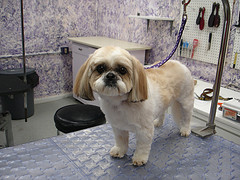We think of dogs as little hairballs, leaving bits of themselves everywhere they go. And while it is true that dog’s do naturally shed a lot, shedding can also be a sign of an underlying health issue.
“Normal dogs shed hair all year long, especially indoor dogs who are less exposed to extremes of temperature and day length changes,” explains Kathryn Primm, DVM owner and practicing veterinarian of Apple Brook Animal Hospital. “When hairs become old or damaged, they fall out. It is a normal process.”
Of course, not all dogs have the same cycle either. Dr. Primm notes that breeds such as the Poodle or Schnauzer have a different hair type that does not shed like other dogs.
“Their hair will continue to grow longer and requires clipping, more like human hair, but the hair length does not seem to be a factor in the hair growth cycle,” she adds.
Skin Irritants
If your dog is irritated by allergens in products you use on him, he can shed more as well. Some will even lose their hair completely. For example, hair shedding and loss can happen with dogs that are allergic to fleas.
“Irritating shampoos can increase shedding if they damage the hair or skin,” Dr. Primm says. “I do not recommend using human shampoos because the perfumes and additives are not tested non irritating for dogs and I much prefer canine labeled shampoos.”
For dogs that are really sensitive, choose limited-ingredient, all-natural shampoos and conditioners. Products with soothing ingredients like oatmeal, lavender, tea tree, and peppermint can also help.
Other Allergens
Believe it or not, shedding can also be a sign that airborn or atopic allergies are bothering your dog.
“It is less likely to be a problem in the winter because a lot of dogs are allergic to spring through fall allergens, like molds and pollens,” says Dr. Primm. “But if your dog is allergic to something in his food or house dust (non-seasonal allergy), you might not see a difference in the winter. The excessive shedding will usually be accompanied by pruritus (itching) and possibly recurrent ear infections, itchy eyes and paw licking.”
If your dog appears to be losing more hair than he is re-growing, it’s time to visit a vet and see if she has allergies.
Food
“Overall health status and diet can also play a role in the hair coat,” she says. “All dogs should eat premium high quality diet and owner should understand that you ‘get what you pay for’ with economy pet food.”
This means staying away from “grocery store brands,” and making sure you are buying (or making!) food that has the right nutrients for your dog, based on his health, age, and activity levels. If you think your dog has food allergies, have him tested so you know what ingredients to avoid.
Your dog’s skin and coat are a good indicator of health. If her coat is not shiny and healthy looking or doesn’t conform to breeds standards (for example, not full enough, soft enough, etc), then it could be a simple matter of switching foods and/or adding supplements.
There are a lot of supplements that you give your dog to help boost coat health and reduce shedding. Things like oils, vitamins, and topicals like tea tree can make a difference.
Serious Health Concerns

Shedding and hair loss can also be a sign of serious health problems.
Dr. Primm says to look for:
- Patches of missing hair
- Reddened skin
- Scabs
- Odor
“There are metabolic disorders that affect the health of the hair coat, like hypothyroidism and Cushing’s Disease,” she explains. “These are diseases that have other, even more serious, consequences, so it is important to see your vet for wellness care and screening every year and more frequently if you notice changes in your dog’s appetite, thirst, energy level or other changes.”
And of course, all kinds of skin issues from mild dermatitis to mange, that can cause excessive shedding and loss. All of which need to be seen by a vet in order to get better.
The main thing is to make sure you are paying attention to your dog’s body and notice if something changes. Your dog’s excessive shedding may be the first sign that a health problem is surfacing. The quicker you identify the issue, the quicker your vet can help you fix the problem or at least reduce your dog’s suffering.
About the Author
Based in Wilsonville, Ore., animal lover Kristina N. Lotz is a Certified Professional Dog Trainer – Knowledge Assessed (CPDT-KA) and works as a full time trainer. She is the founder of A Fairytail House, a unique all-positive all-sport dog training facility that helps rescue dogs in her area and provides free seminars and training classes for the community. In her spare time, she trains and competes in herding, agility, obedience, rally, and conformation with her Shetland Sheepdogs. She smartly married a Veterinary Technician, who helps keep the fur kids happy and healthy, and provides a quick resource for articles.
 Toledo, United States.
Toledo, United States.